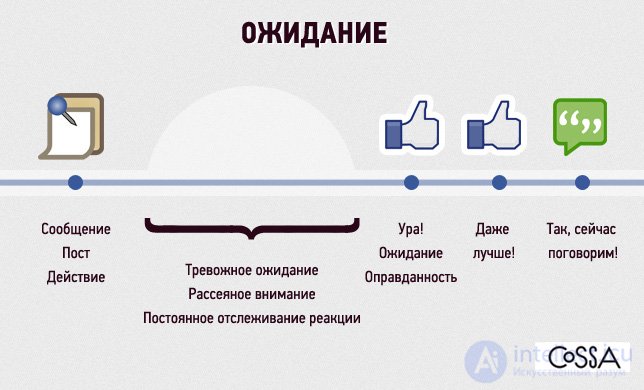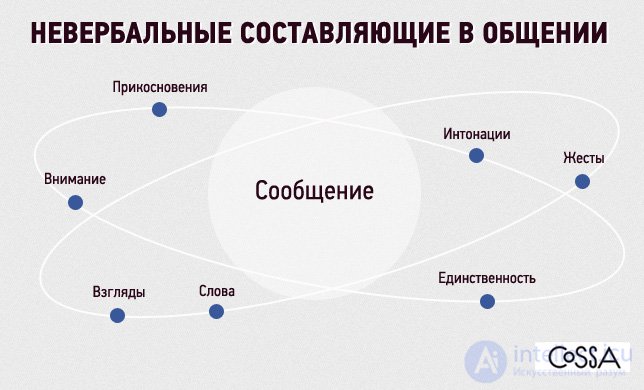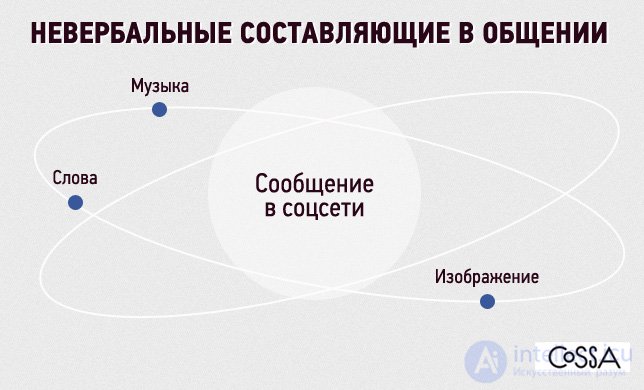Lecture
The behavior of users in a social network is often determined by the expectation. Every person has a completely normal desire to get a response to their actions.
Human behavior in a social network is expressed by the following scheme:

A person immediately receives a response to most of his actions in the real world. If you look into a person’s eyes and ask a question, it’s immediately clear whether he will answer or not. In the social network it is not known when the response to any committed action will come.
In response to an action in a social network, a waiting period for a reaction is formed, and it is not known whether the waiting will end with a reaction or not. And if it ends, then which one.
For example, you never know when a response to a private message will be received, even if the user is online. Often, a person does not realize that he expects in response to his action - like, discussion or repost?
You can draw a physical analogy that all users are in a large room, go about their business, and from time to time go to the center and shout something. In response, they can be patted on the shoulder or answered, or they can be completely ignored. Sometimes, users may experience a sense of uncertainty - they notice the surrounding cry or not.
All these statements in the void, unclear expectations and late responses keep a person in a state of unfinished mini-gestalt and unreported reactions. And you can complete them only if you return to the social network.
The full meaning of the transmitted message in the social network is lost.
When a young man communicates with a girl in a cafe, looks at her, he receives her messages containing a whole set of non-verbal parameters.

In social networks, only verbal perception.

When communicating in a social network, it is sometimes difficult to interpret even a smiley. What does he express - a friendly smile or sarcastic laugh?
After communication in a social network, a feeling of understatement often remains. A sort of unfinished mini-gestalt. Inexpressiveness of all thoughts and feelings. The feeling that someone is stealing the attention of the interlocutor. From all this, the full meaning of the transmitted message is lost.
And everything seems to be said, and understood, but the feeling of understatement remains. And it remains not due to the fact that there are not spoken words. This feeling arises because of the desire and inability to put non-verbal components into messages - facial expressions, emotions, personal presence, gaze, smile or laughter.
When communicating on the network, it is impossible to know exactly why people do not respond to messages: because the girl left to make coffee so as not to fall asleep and sit still half the night, or (oh, horror!) She communicates with someone else. It is not known - those songs, comments and huskies that are left on its wall are only friendly signs, or important meanings are kept in the lyrics of songs that are inaccessible to an outside observer.
People do not see the entire message, and the situation of uncertainty begins to give rise to interpretations of the visible, usually false and far-fetched.
Social networks solve the problem of synchronization of human states. As well as private correspondence.
In life, we often stumble upon the fact that our interlocutor is not ready to accept our message - at the moment of addressing him he is busy with business or other thoughts.
On the network, these situations are partially smoothed by the fact that you can postpone a response to a message until the mood or opportunity comes.
Realizing his mistakes, having decided in the evening that he would become better, he would study, Marcel, with these thoughts, waking up in the morning, rushes into the arms of his mother. She is at this time, being in another spiritual point, suddenly pushes him away. And Proust remarks: how often we are not synchronized, do not coincide in points, we love when we are not loved.
- Merab Mamardashvili "Lectures about Proust."
Would send Marcel a letter, instead of throwing himself into an embrace - you see, his mother would find the time and attitude to respond to the message as it should.
True, the message would not convey all the feelings of little Marcel.
One of my friends met a young man. They had an active correspondence for two days. On the third day, I receive a message from her in the afternoon: “He sits online and does not write.” And the girl begins to worry in vain: "He does not think about me, he does not write to me, because I have ceased to be interesting to him."
This is a frequent example of misunderstanding online. In the modern world, online state means only one thing - a person has a computer turned on. Whether he is behind him, what he does and whether he is ready to communicate - all this state online does not show.
Anton Nosik somehow noticed that people do not tend to divide others into circles, as suggested by the user on Google+. If you look at what boundaries a person observes on a social network, it turns out that there are only three types of communication:
For the first two groups, the communication functionality has been developed, and for the third group, we have only private messages.
One would assume that in the future there will be opportunities to connect two personalities into a local network with limited access. This assumption is based on analogy in life - the connection between two people is not limited to messages, there are some other common aspects that live in the human consciousness and the material world.
Probably, such a service could be something like a common wall, access to which would have only two participants.
It can be assumed that social retirement would be actively used by couples in love - this is precisely the space when the third is superfluous.
Now on VKontakte, for example, messages of lovers on a common wall look, at least, strange - it's like two kissing at a table at a business conference.
Comments
To leave a comment
SMM Social Media Promotion
Terms: SMM Social Media Promotion